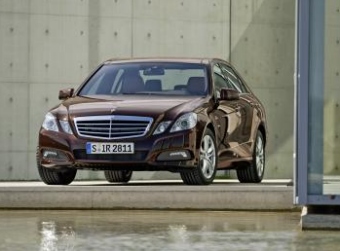
Automotive Intelligence - the web for automotive professionals and car enthusiasts
January 13, 2009
This Week:
-
Ford Presents Lincoln C Concept As Big Luxury In Small Package
-
GM Rally Showcases 16 New and Upcoming Cars and Crossovers at North American International Auto Show
-
Honda Insight Hybrid Makes World Debut at the Detroit Motor Show
-
smart examining potential of electric fortwo in the United States
-
Jaguar Reveals New XFR and XKR at 2009 North American International Auto Show
-
Kia Motors America Showcases the Soul'ster Concept at 2009 North American International Auto Show
© 1998 - 2009
Copyright &
Disclaimer
Automotive Intelligence,
www.autointell.com
All Rights Reserved .
For questions please contact
editor@autointell.net
|
The new Mercedes-Benz E-Class: all-round safety, outstanding comfort and up to 23 percent fuel savings
Detroit – With the new E-Class, Mercedes-Benz is presenting the pacemaker when it comes to safety, comfort and environmental compatibility in this market segment. With more than 20 new or further technical developments, this saloon further consolidates the leading position of Mercedes-Benz in the luxury class. They include trailblazing innovations for safe driving that are available from no other manufacturer worldwide in this combination. Examples include the standard Attention Assist, Adaptive Main Beam Assist and automatic emergency braking, which is activated when there is acute danger of a collision. |
|
|
|
Mercedes-Benz has improved the already exemplary long-distance comfort of the E-Class even further in the new saloon, including intelligent bodyshell technology with up to 30 percent greater rigidity, further improved seats and a newly developed suspension whose shock absorbers automatically adjust to the current driving situation. The optional air suspension now works together with an electronic damping system. |
The outstanding safety and comfort of the E-Class are matched by its environmental compatibility and economy: the four- and six-cylinder engines are direct-injection units, and consume up to 23 percent less fuel than before. The combined NEDC consumption of the new four-cylinder diesel engines is just 5.3 litres per 100 kilometres, which corresponds to 139 grams of CO2 per kilometre. All the engines for the new E-Cass meet the EU5 emission standard, and in the case of the E 350 BlueTEC the emissions are already below the EU6 limits planned for 2014 .
Apart from the engines, the BlueEFFICIENCY package for the E-Class is in large part responsible for a considerable fuel saving. Engineers from every development department have worked together to optimise assemblies and components, to save fuel by means of reduced weight, a new form, improved functioning or efficient energy management.

The work done in the wind tunnel was particularly successful, for with a drag coefficient of only 0.25, the new E-Class is the world’s most aerodynamically efficient luxury saloon. It betters the already good Cd figure of the preceding model by another four percent, which represents a fuel saving of around 0.25 litres per 100 kilometres when driving at a motorway speed of 130 km/h. The aerodynamics are for example improved by variable fan louvres, which control the airflow to the engine compartment in line with requirements.
Other BlueEFFICIENCY measures include newly developed tyres with up to 17 percent lower rolling resistance, energy-saving control of the generator, fuel pump, air conditioning compressor and power steering, and the ECO start/stop function which switches the engine of the new E 200 CGI off when idling. Displays in the speedometer inform the driver how much fuel is being consumed (per 100 kilometres), and when he should shift to the next higher gear in the interests of an economical and environmentally conscious style of driving.
The range of engines available for the new E-Class comprises four, six and eight-cylinder units with outputs from 100 kW/136 hp to 386 kW/525 hp. The four-cylinder engines are newly developed direct-injection units, which develop a higher output and torque than the comparable V6-engines of the preceding series despite a smaller displacement.
The strategy is to replace to replace large, naturally aspirated engines with turbocharged units which excel with advantages such as lower weight, reduced internal friction and more economical operating characteristics.
Engines: new CDI-four-cylinder units with a fuel consumption of just 5.3 litres and 139 grams of CO2 per kilometre
With three completely newly developed four-cylinder engines, the E-Class also remains one generation ahead where diesel technology is concerned. These engines feature latest-generation common-rail direct injection, fast piezo-electric injectors, improved exhaust gas recirculation and an innovative twin turbocharger, making for fast responsiveness and good performance characteristics.
To express this in figures, the E 250 CDI with 150 kW/204 hp and 500 newton metres develops a 25 percent higher torque than the previous V6 diesel engine, but uses around 23 percent less fuel at only 5.3 litres per 100 kilometres (combined NEDC consumption). This corresponds to 139 grams of CO2per kilometre.
The new four-cylinder diesel engine also powers the E 220 CDI with 125 kW/ 170 hp and the E 200 CDI with 100 kW/136 hp, also with a fuel consumption of only 5.3 litres per 100 kilometres. The top model in the new E-Class diesel range is the six-cylinder E 350 CDI with an output of 170 kW/231 hp, which uses 0.5 litres per 100 kilometres less fuel than the previous E 320 CDI.
From autumn 2009 the V6 diesel will also be available as a BlueTEC model with the world’s best emission control technology. The E 350 BlueTEC develops 155 kW/211 hp and meets the EU6 exhaust emission standards planned for 2014. All the other engine variants in the new E-Class meet the EU5 limits.
The new E-Class will appear in the showrooms of the European Mercedes sales and service outlets and dealerships in March 2009.
Photos: Mercedes-Benz
(Jan. 11, 2009)
| .
Homepage News Companies Management Publications Events Guestbook Search . |
